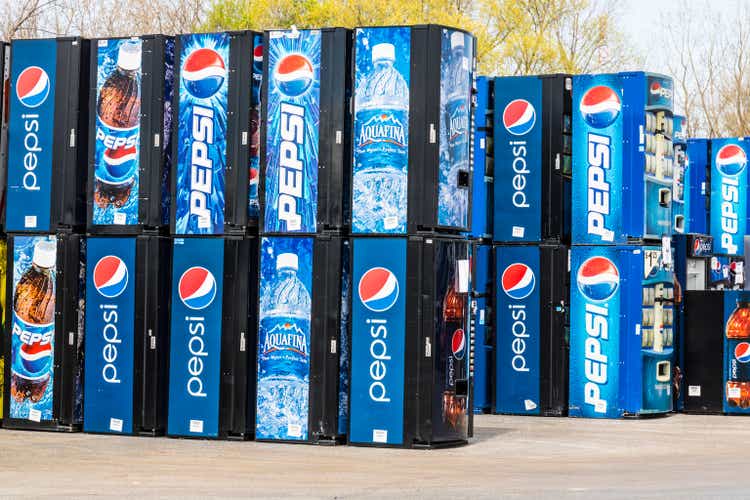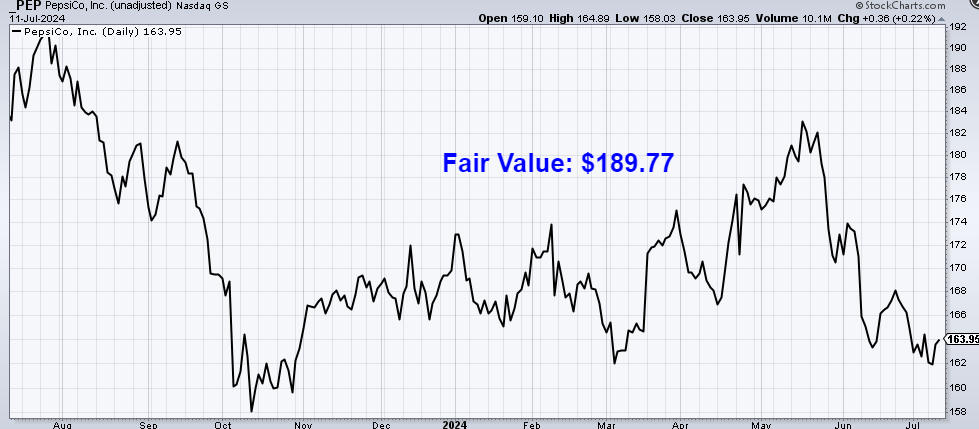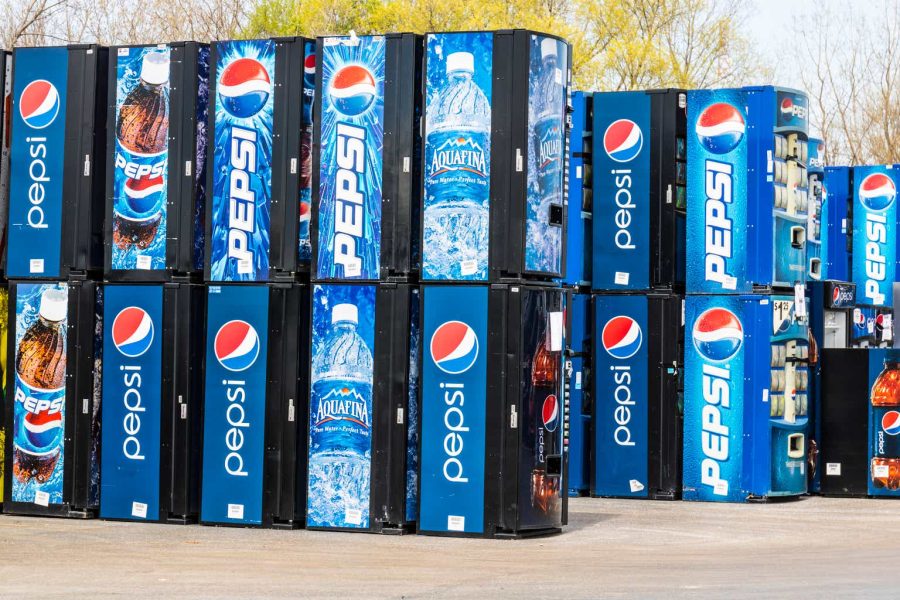Summary:
- PepsiCo, an American multinational food, snack, and beverage corporation, is now a $226 billion (by market cap) food and beverage beast.
- PepsiCo has built up more than 20 different billion-dollar brands.
- PepsiCo has increased its dividend for 52 consecutive years, with a 10-year dividend growth rate of 8.1%.
- PepsiCo moved its revenue from $66.7 billion in FY 2014 to $91.5 billion in FY 2023, a compound annual growth rate of 3.6%.
jetcityimage/iStock Editorial via Getty Images
PepsiCo, Inc. (NASDAQ:PEP) is an American multinational food, snack, and beverage corporation. Founded in 1898, PepsiCo is now a $226 billion (by market cap) food and beverage beast that employs more than 300,000 people.
The company reports results across seven segments: PepsiCo Beverages North America, 30% of FY 2023 revenue; Frito-Lay North America, 27%; Europe, 14%; Latin America, 13%; Africa, Middle East, and South Asia, 7%; APAC (Asia Pacific), 5%; and Quaker Foods North America, 3%. The company generates approximately 57% of revenue from the US; the remainder is generated internationally.
PepsiCo is a highly alluring business model for long-term investment. A big reason for this? The business model is easily understandable. This company sells basic beverage and snack products that are likely to be regularly consumed by nearly everyone reading this article (as well as the guy who wrote it). We’re talking sodas, chips, water, energy drinks, etc.
The simplicity and familiarity is comforting. Simple sometimes has a negative connotation to it, but simplicity can be wildly successful. See, PepsiCo is in the business of providing timeless, consumable products that feature low ticket prices, leading to lots of repeat purchases and recurring revenue. For example, once a bag of chips is gone, you need to go out and buy another bag of chips. And since chips are cheap and enjoyable, it’s easy to make those small, consistent purchases.
Well, PepsiCo has taken this basic idea and supercharged it through the might of brands, giving the company a high degree of visibility and pricing power in the marketplace among loyal consumers who desire a certain level of reliable flavor and quality.
Indeed, PepsiCo has built up more than 20 different billion-dollar brands (i.e., brands that do more than $1 billion per year in sales) – including the likes of Aquafina, Doritos, Lay’s, Mountain Dew, and the eponymous Pepsi. The pricing power those brands confer to PepsiCo allows the company to slowly raise prices over time, protecting the business (and shareholders) against inflation and rising input costs.
When you put it all together, it’s not a surprise to see how PepsiCo’s bevy of enjoyable, low-cost, branded products have led to a wonderful track record of steadily rising revenue and profit, in turn leading to a steadily rising dividend back to shareholders.
Dividend Growth, Growth Rate, Payout Ratio and Yield
The dividend track record is so wonderful, it dates back decades. Yes, PepsiCo has increased its dividend for 52 consecutive years. That easily qualifies PepsiCo for its status as an esteemed Dividend Aristocrat (25+ consecutive years of dividend increases). In fact, this has become a Dividend Aristocrat twice over and is now a Dividend King (50+ consecutive years of dividend increases). Basically, it’s dividend royalty.

The 10-year dividend growth rate of 8.1% just goes to show that a growth slowdown isn’t a given – even multiple decades into the dividend growth story. The most recent dividend raise was 7.1%, while last year’s dividend raise was 10%.
So PepsiCo is reliably growing its dividend at a high single-digit level. And you get to layer that growth on top of the stock’s market-beating 3.4% yield. That’s unusually high. This yield is 70 basis points higher than its own five-year average.
With a payout ratio of 66.5%, based on FY 2024 guidance for core EPS, the dividend is positioned to grow roughly in line with the business. Very solid stuff here.
If one can get 7%+ dividend growth and 3%+ yield, that’s setting things up for a 10+ annualized total return (assuming a no major changes to the valuation). From a mature beverage and snack food company, that’s not bad at all.
Revenue and Earnings Growth
As solid as these numbers are, though, many of the metrics are looking backward. However, investors must always be looking forward, as the capital of today is risked for the rewards of tomorrow. As such, I’ll now build out a forward-looking growth trajectory for the business, which will be highly useful when the time comes to estimate intrinsic value.
I’ll first show you what the business has done over the last decade in terms of its top-line and bottom-line growth. I’ll then reveal a professional prognostication for near-term profit growth. Lining up the proven past with a future forecast in this manner should give us enough information to judge where the business may be going from here.
PepsiCo moved its revenue from $66.7 billion in FY 2014 to $91.5 billion in FY 2023. That’s a compound annual growth rate of 3.6%. Decent. I like to see at least a mid single-digit top-line growth rate from a large, mature business like this. It’s close.
Meanwhile, earnings per share grew from $4.27 to $6.56 over this period, which is a CAGR of 4.9%. If we use core EPS for FY 2023 ($7.63), the 10-year CAGR jumps to 6.7%. Modest margin expansion and regular buybacks drove excess bottom-line growth. Regarding the latter, the outstanding share count is down by nearly 10% over the last decade. Overall, these are good – not great – numbers out of PepsiCo.
Notably, dividend growth has been faster than business growth over the last 10 years, and that’ll have to be reconciled over the near term. Looking forward, CFRA expects that PepsiCo will compound its EPS at an annual rate of 10% over the next three years. CFRA highlights “the power of its various brands, such as Frito-Lay, Gatorade, Pepsi, and Mountain Dew, in an inflationary environment, as we believe they give the company the ability to successfully pass through higher costs to consumers in the form of price increases.”
Agreed on all of this, although it should be noted that volumes have recently been slightly weak in the face of price increases. Indeed, CFRA concedes that “…benefits from price increases are offset by lower volumes and various cost pressures.” CFRA also states: “Longer term, we see faster-growing international markets and the Frito-Lay business as the primary growth drivers. [PepsiCo]’s focus on healthier snacks and beverages will also continue to drive the top line.”
One interesting aspect of PepsiCo is its dive into popular, faster-growing energy drinks, as the company acquired Rockstar Energy for nearly $4 billion in 2020 and more recently acquired an 8.5% ownership stake (though convertible preferred stock) in Celsius Holdings, Inc. (CELH).
PepsiCo is moving the needle, but I think a 10% expectation is too optimistic. PepsiCo itself is guiding for $8.15 in core EPS for FY 2024, which would represent 6.8% YOY growth. And that ~7% number jibes with the 10-year EPS CAGR (assuming core EPS for FY 2023), and it’s not far off from the 10-year dividend growth rate. A 10% EPS CAGR isn’t necessary for PepsiCo to be a satisfactory long-term investment, and I’d moderate my assumptions over what this business will likely do over the coming years.
A ~7% growth rate – both in terms of EPS and the dividend – would still be enough to drive a ~10% annualized total return. It’s not lighting the world on fire, but this is a no-fuss, blue-chip business that could double your money every decade. I have a hard time not liking that kind of setup.
Financial Position
Moving over to the balance sheet, PepsiCo has a good (but far from excellent) financial position. The long-term debt/equity ratio is 2, while the interest coverage ratio is 15. The former number appears to be worse than it really is, due to abnormally low shareholders’ equity, but a ~$38 billion long-term debt load is not all that large when measured against the market cap.
I’d like to see a better balance sheet, but I’m not overly concerned by PepsiCo’s situation. Profitability is superb.
Return on equity has averaged 56.9% over the last five years, while net margin has averaged 11.2%. ROE has been juiced by the balance sheet, but even ROIC is routinely in the high-teens area. The returns on capital are decently high.
PepsiCo isn’t growing super fast, but it’s a blue-chip, defensive business with some of the best brands in the world. And with economies of scale, a global distribution network, IP, R&D, brand power, and established retail relationships with a large amount of shelf space, the company does benefit from durable competitive advantages.
Of course, there are risks to consider. Regulation, litigation, and competition are omnipresent risks in every industry. Technology and the rise of alternative forms of media make it easier for new entrants to come to market, advertise, make themselves known to consumers, and compete with entrenched juggernauts like PepsiCo.
Trends toward healthier foods may negatively impact PepsiCo and many of its products that cater to taste appeal over health. PepsiCo must continue to navigate different tastes in different markets, as well as changing consumer tastes and preferences.
The company’s international footprint exposes it to fluctuating currency exchange rates. Input costs can be volatile. Passing on higher costs and raising prices on products can lead to strained relationships with retailers, as has recently been seen with certain retailers in Europe.
The balance sheet isn’t as strong and flexible as it used to be, which somewhat limits what management can do with capital allocation. PepsiCo’s size may be a hindrance to future returns (i.e., the law of large numbers). There are risks here, as there are with any business, but I don’t see an especially worrisome risk profile. And one has to weight the risks present against the quality and valuation of the business.
Valuation
The stock’s P/E ratio is sitting at 24.6. That’s using TTM GAAP EPS. Using guidance for this year’s core EPS, the forward P/E ratio drops to 20. These are surprisingly low numbers for one of the bluest blue-chip businesses in the world, and they compare favorably to the stock’s own five-year average P/E ratio of 25.
The cash flow multiple of 16.1, which is reasonable, is also lower than its own five-year average of 19.2. And the yield, as noted earlier, is significantly higher than its own recent historical average.
So the stock looks cheap when looking at basic valuation metrics. But how cheap might it be? What would a rational estimate of intrinsic value look like?
I valued shares using a dividend discount model analysis. I factored in a 10% discount rate and a long-term dividend growth rate of 7%. So there’s that 7% number again, which has been a theme throughout today’s writeup. That’s basically the rate at which PepsiCo appears poised to grow its dividend over the coming years, which is only modestly lower than the demonstrated dividend growth rate over the last decade. For further reassurance, this is almost exactly in line with the most recent dividend raise, and I think that’s a great baseline for the go-forward expectation.
The DDM analysis gives me a fair value of $193.31. The reason I use a dividend discount model analysis is because a business is ultimately equal to the sum of all the future cash flow it can provide. The DDM analysis is a tailored version of the discounted cash flow model analysis, as it simply substitutes dividends and dividend growth for cash flow and growth. It then discounts those future dividends back to the present day, to account for the time value of money since a dollar tomorrow is not worth the same amount as a dollar today.
I find it to be a fairly accurate way to value dividend growth stocks. This looks like a pretty cheap blue-chip name from my point of view. But we’ll now compare that valuation with where two professional stock analysis firms have come out at. This adds balance, depth, and perspective to our conclusion.
Morningstar, a leading and well-respected stock analysis firm, rates stocks on a 5-star system. 1 star would mean a stock is substantially overvalued; 5 stars would mean a stock is substantially undervalued. 3 stars would indicate roughly fair value. Morningstar rates PEP as a 4-star stock, with a fair value estimate of $176.00.
CFRA is another professional analysis firm, and I like to compare my valuation opinion to theirs to see if I’m out of line. They similarly rate stocks on a 1-5 star scale, with 1 star meaning a stock is a strong sell and 5 stars meaning a stock is a strong buy. 3 stars is a hold. CFRA rates PEP as a 4-star “buy“, with a 12-month target price of $200.00. I’m roughly in the middle on this one. Averaging the three numbers out gives us a final valuation of $189.77, which would indicate the stock is possibly 14% undervalued.

Bottom line: PepsiCo, Inc. is a high-quality, blue-chip business with more than 20 different beloved, billion-dollar brands. Its visibility is nearly unrivaled. With a market-beating yield, high single-digit dividend growth, a manageable payout ratio, more than 50 consecutive years of dividend increases, and the potential that shares are 14% undervalued, dividend growth investors who like buying Dividend Aristocrats and Dividend Kings at discounts may have a no-brainer idea here.
Note from D&I: How safe is PEP’s dividend? We ran the stock through Simply Safe Dividends, and as we go to press, its Dividend Safety Score is 93. Dividend Safety Scores range from 0 to 100. A score of 50 is average, 75 or higher is excellent, and 25 or lower is weak. With this in mind, PEP’s dividend appears Very Safe with an unlikely risk of being cut.

Disclosure: I’m long PEP.
Editor’s Note: The summary bullets for this article were chosen by Seeking Alpha editors.
